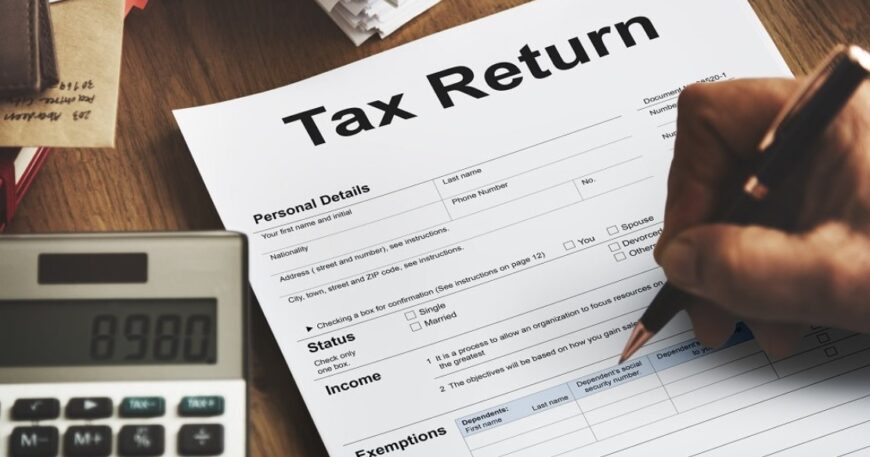Introduction
When it comes to managing taxes, many individuals and businesses need assistance navigating through the complexities of tax returns. Whether it’s filing your annual tax return, checking the status of a refund, or understanding the process of an amended tax-return, having reliable guidance can save you time and stress. At Syed Professional Services, we understand how confusing tax-related matters can be, and we are here to ensure that your tax filing process is smooth, efficient, and error-free. In this blog, we will walk you through the essential information about tax-returns, including IRS tax return status, how to file an amended tax-return, and where to mail your federal tax return.
What is a Tax Return?
A tax return is a document filed with the Internal Revenue Service (IRS) or a state tax agency that reports income, expenses, and other pertinent tax information. The purpose of the tax return is to calculate whether the individual or business owes taxes or is entitled to a refund. Filing a tax return is essential for taxpayers to fulfill their legal obligations and ensure they are compliant with tax laws.
Understanding the Different Types of Tax Returns
- Federal Tax-Return: A document filed with the IRS to report income, deductions, and other financial information.
- State Tax-Return: Similar to the federal tax return but specific to your state’s tax laws and rates.
- Amended Tax-Return: Filed if you need to make corrections or adjustments to a previously submitted return.
Each type of tax return serves a specific purpose, and it’s important to understand what documents you need to file and when to ensure you meet all deadlines and avoid penalties.
Tax Return Status: How to Check the Status of Your Tax Return
One of the most common questions taxpayers ask is, “Where is my tax return?” Knowing the status of your tax-return is important, especially if you’re eagerly awaiting a refund. Fortunately, the IRS offers tools that allow taxpayers to track the status of their return and refund.
How to Check Your IRS Tax Return Status:
- IRS Website: The IRS offers an online tool called “Where’s My Refund?” This tool provides updates on the status of your refund, including whether it has been processed, approved, or mailed.
- IRS2Go Mobile App: This is another convenient way to check the status of your tax-return directly from your smartphone.
- Call the IRS: If online tools aren’t providing the information you need, you can call the IRS at 1-800-829-1040 for assistance.
Be sure to have your tax return details ready when checking the status, such as your Social Security number, filing status, and the exact amount of your expected refund.
Where is My Tax Return? Understanding Tax Return Processing Times
It’s natural to wonder when you’ll receive your tax return, but keep in mind that tax returns are processed in batches, and timelines can vary. Typically, if you file electronically, you can expect your refund in about 21 days. Paper returns may take longer.
IRS Tax Return Status Updates:
- Approved: Your return has been accepted and is being processed.
- Refund Sent: Your refund has been mailed to you.
- Processing: The IRS is still reviewing your return.
For the most accurate and up-to-date information, check the IRS tools mentioned above.
When Do I Get My Tax Return? Understanding Refund Timelines
After filing your tax return, many taxpayers eagerly await the arrival of their refund. The IRS aims to process tax refunds as quickly as possible, especially for those who file electronically. However, several factors can affect the timeline.
Factors That Affect Tax Return Timing:
- Filing Method: E-filing typically results in faster processing than paper filing.
- Refund Type: If you chose direct deposit, your refund may arrive faster than if you opted for a check.
- Errors or Missing Information: Mistakes on your tax-return can delay the processing of your refund.
- Tax Season Volume: During peak tax season, processing times may be longer due to high volumes of returns.
How to Get a Copy of Your Tax Return Online
If you need a copy of your previous tax returns for personal or business purposes, it’s easy to request them online through the IRS website.
Steps to Request Your Tax Return:
- Use the IRS Online Tool: The IRS offers a “Get Transcript” tool where you can download a copy of your tax return transcript. This includes key information from your filed return.
- Order by Mail: If you prefer a hard copy, you can request a transcript by mail via the IRS website.
- Request Through Form 4506: If you need an official copy of your tax return, you’ll need to submit Form 4506, Request for Copy of Tax Return.
It’s important to keep records of your tax returns for at least three years to avoid complications in case of an audit.
IRS Tax Return: Key Facts You Should Know
The IRS (Internal Revenue Service) is responsible for processing tax returns and ensuring that taxpayers meet their legal obligations. Here are some important things to know about the IRS tax return process:
- The IRS uses tax returns to calculate the taxes owed and to determine if a refund is due.
- Taxpayers must file returns by the annual deadline, typically April 15 (unless extended).
- The IRS can issue penalties for late filing, incorrect information, or failure to file altogether.
For those who struggle with the complexities of IRS tax returns, working with a tax professional or service like Syed Professional Services can ensure that your return is filed accurately and on time.
Amended Tax Return Status: How to File an Amended Return
If you’ve made an error on your initial tax-return, filing an amended tax return is necessary to correct the mistake. This could involve changes such as updating your filing status, correcting income details, or adjusting deductions.
How to File an Amended Tax Return:
- Obtain IRS Form 1040-X: This is the form used to file an amended return.
- Fill Out the Form: Provide the corrected information on the form, including the original amounts and the changes made.
- Submit the Form: Mail the completed form to the IRS. Note that amended returns cannot be filed electronically.
- Check the Status: You can track the status of your amended return online through the IRS’s “Where’s My Amended Return?” tool.
Common Reasons to File an Amended Tax Return:
- Error in Filing Statu/s
- Incorrect Income Reporting
- Missed Deductions or Credits
- Changes in Dependents
Where to Mail Federal Tax Return:
If you’re filing your tax return by mail, you’ll need to know the correct address for submitting your federal tax-return. The address varies based on your state of residence and the type of return you’re filing.
- Use the IRS Mailing Address Lookup Tool: The IRS website provides an easy-to-use tool to find the correct address.
- Be Sure to Include All Documentation: When mailing your return, ensure that you include all required forms and documents to avoid delays.
Conclusion
Navigating the world of tax returns can be overwhelming, but with the right knowledge and resources, you can ensure that your filings are completed accurately and on time. At Syed Professional Services, we offer expert assistance with IRS tax-returns, amended returns, and federal tax filing. Whether you’re wondering where your tax return is, how to check the status, or how to file an amended return, we’re here to help you every step of the way.
FAQs
- What is the difference between a federal and state tax return? A federal tax return is filed with the IRS, while a state tax return is filed with your state’s tax authority.
- How long does it take to get a tax refund? Tax refunds typically take 21 days if you file electronically and choose direct deposit.
- How can I amend my tax-return? You can amend your tax return by filing IRS Form 1040-X.
- Where do I mail my federal tax-return? The IRS provides a mailing address lookup tool to determine where to send your return.
- How can I check the status of my tax-return? You can use the IRS’s “Where’s My Refund?” tool or call their customer service for status updates.
- How can I get a copy of my previous tax-return? You can request a transcript or an official copy of your tax return through the IRS website.

How to File a Federal Tax Return: A Step-by-Step Guide
Filing your federal tax return can feel daunting, especially if it’s your first time or if you have complex financials. However, with the right steps, the process can be straightforward and stress-free. Here’s a quick guide to help you understand the steps involved in filing a federal tax return.
- Gather Your Documents: Start by collecting all the necessary documents, such as:
- W-2 Forms (for employees)
- 1099 Forms (for contractors or freelancers)
- Receipts for deductions (medical, business expenses, etc.)
- Bank statements
- Social Security Number (SSN) or Taxpayer Identification Number (TIN) for all individuals listed on your return.
- Choose Your Filing Method: You can file your federal tax return through one of two methods:
- E-Filing: This is the fastest and most accurate way to file your taxes. Using tax software or professional services like Syed Professional Services, you can file your return electronically, receive quicker processing, and even get direct deposit for your refund.
- Paper Filing: If you prefer to file by paper, download the appropriate forms from the IRS website, fill them out manually, and mail them to the correct IRS address.
- Complete Your Tax-Return: Whether you are filing electronically or manually, make sure to complete your return accurately. Ensure that all your income, deductions, and credits are accounted for.
- File Your Tax-Return: Once your tax return is complete, submit it through your chosen method. If you are e-filing, the IRS will send you an electronic acknowledgment. For paper filers, you’ll need to mail your return to the appropriate address based on your state and type of return.
- Track Your Refund: If you’re expecting a refund, you can track its status using the IRS’s “Where’s My Refund?” tool. Be sure to double-check your details, including the expected refund amount, filing status, and Social Security Number to get accurate information.
Amended Tax Returns: When and How to File One
Sometimes, mistakes happen, and you may need to file an amended tax-return to correct errors from your original filing. It’s important to know when and how to file an amended return properly.
Reasons for Filing an Amended Return:
- Incorrect Filing Status: If you selected the wrong filing status, such as filing as single when you should have filed as married, you may need to amend your return.
- Missed Deductions or Credits: You may have forgotten to claim a deduction or credit, which could result in a larger refund or a reduced tax liability.
- Reporting Errors: If you made an error while reporting income, expenses, or other financial details, an amended return can correct those mistakes.
Steps to File an Amended Tax Return:
- Obtain IRS Form 1040-X: This is the form required to amend your tax return.
- Fill Out the Form: Indicate the changes and corrections on the form, explaining why the amendment is necessary.
- Mail the Form: After completing the form, mail it to the IRS. Remember, amended returns cannot be filed electronically.
- Wait for Processing: Amended returns typically take around 16 weeks to process, so be patient while waiting for the IRS to review and update your records.
IRS Tracking for Amended Returns:
To track the status of your amended return, you can use the IRS “Where’s My Amended Return?” tool. This service provides updates on the progress of your amendment, helping you stay informed on the status of your return.
IRS Tax Return Status: Understanding Your Refund Timeline
It’s essential to understand that while the IRS strives to process tax returns promptly, various factors can affect your refund timeline. The IRS issues most refunds within 21 days for e-filed returns, but this can vary based on several elements. Let’s take a closer look at what could impact your refund timeline.
Factors That Affect IRS Tax Return Status:
- E-File vs. Paper Filing:
- E-File: If you file your tax-return electronically, your return is processed faster, and you typically receive your refund within 21 days.
- Paper Filing: Paper returns take much longer to process, often up to six weeks or more.
- Direct Deposit vs. Check Refund: If you choose direct deposit for your refund, you’re more likely to receive it faster than if you opt for a paper check.
- Additional Review by the IRS: If the IRS needs to review your return for any reason, such as mismatched information or missing documentation—it could delay your refund.
- Tax Season Delays: The IRS experiences a high volume of tax returns during peak season, which can affect processing times.
Common IRS Refund Status Updates:
- Refund Sent: Your refund has been issued and sent to your bank or by check.
- Refund Approved: The IRS has approved your refund, and it’s being processed.
- Processing: The IRS is still reviewing your return.
- Returned: If there’s an issue with your bank details, your refund could be returned.
What Happens if I Don’t File My Tax Return on Time?
If you fail to file your tax-return by the deadline, you could face penalties and interest charges. However, it’s important to note that filing late doesn’t necessarily mean you won’t owe anything; if you owe taxes and fail to file on time, you may be subject to additional penalties.
Penalties for Not Filing Your Tax Return:
- Failure to File Penalty: If you don’t file your return on time, you could face a penalty of 5% of your unpaid taxes for every month your return is late, up to 25% of your total unpaid taxes.
- Failure to Pay Penalty: If you owe taxes and don’t pay on time, the IRS charges interest on the unpaid amount, and this can add up quickly.
How to Avoid Late Filing Penalties:
- File for an Extension: If you need more time to prepare your return, you can file for an automatic six-month extension with the IRS. However, this does not extend the time to pay any taxes you owe.
- Pay What You Owe: Even if you can’t file on time, it’s important to pay any taxes you owe by the original deadline to avoid penalties and interest charges.
Conclusion: Get Expert Help with Tax Returns at Syed Professional Services
Tax returns can be complicated, but with the right resources, they don’t have to be overwhelming. Whether you’re filing your federal tax return, checking the status of your refund, or needing help with an amended return, Syed Professional Services is here to help. We provide expert assistance to ensure your taxes are filed accurately, on time, and in full compliance with IRS regulations.
Our team is dedicated to helping you navigate the complexities of tax filing, maximizing your refund, and minimizing your stress during tax season. Don’t hesitate to reach out for personalized, professional tax services that make your life easier.
FAQs
- Can I file my tax-return online? Yes, e-filing is the fastest way to file your tax-return and get your refund quicker.
- How can I check my refund status? Use the IRS “Where’s My Refund?” tool online or through the IRS2Go mobile app.
- What should I do if I miss the tax filing deadline? You can file for an extension or pay your taxes online to avoid penalties.
- How long does it take for the IRS to process an amended return? It typically takes up to 16 weeks for the IRS to process an amended tax-return.
- Where do I mail my federal tax-return? The IRS provides a tool on its website to find the correct mailing address based on your location and type of tax-return.
- What do I do if I need a copy of my past tax-returns? Request a transcript or a copy of your tax-return using the IRS “Get Transcript” tool or Form 4506.






